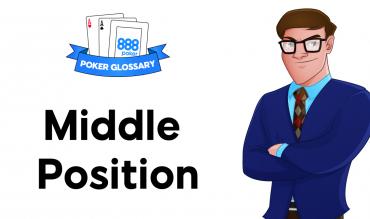The term ‘middle position’ in poker refers to several different seats at the poker table which act after the early positions on the preflop betting round.
In short handed (6-max) games the term middle position applies exclusively to the hijack seat (so only one position at the table).
In full ring games the term middle position can apply to either the hijack, lojack or MP1 (middle position 1). There are therefore 3 unique table positions that are covered by the umbrella term middle position.
In this guide we’ll learn the following -
- Why is it called middle position in poker?
- What is middle position in 6-handed poker?
- What are the middle positions in full ring poker?
- What is a good middle position winrate?
- How should we play against middle position opens?
- Is it possible to steal the blinds from middle position?
- How aggressively should we open raise from middle position?
Why is it Called Middle Position in Poker?
It is named middle position in poker simply because it is neither late position nor early position. The button and cutoff are examples of late positions while the under-the-gun(UTG) positions are examples of early positions at the poker tables. The middle positions at the poker table come after the early (UTG) positions.
What is Middle Position in 6-handed Poker?
The term middle position applies exclusively to the hijack position when talking about 6-handed poker. In fact, the term middle position is used far more commonly than hijack amongst 6-max players. Middle position is to the direct right of the cutoff and direct left of UTG on a 6-handed table.
What are the Middle Positions in Full Ring Poker?
The three middle positions in full ring poker are the hijack, lojack and mp1 (middle position 1). There will eventually be less than three middle positions if players leave the table. For example, a 7-handed table has two middle positions while a 6-handed table has just 1 middle position.
What is a Good Middle Position Winrate?
Players do not expect especially high winrates from middle position but they do expect positive winrates (since folding is considered break-even). A rough guide might be a winrate of 10 to 15bb/100 hands from the middle positions.
How Should we Play Against Middle Position Opens?
Middle position opens are generally on the strong side and should be given a decent amount of respect. While we can still cold-call and three-bet against middle-position open raises we should use a stronger range than we would when defending against later position opens.
Is it Possible to Steal the Blinds in Middle Position?
The middle positions are not typically considered good seats to try and steal the blinds from. While there may be some exceptions if there are especially tight players behind, we should usually look to open-raise with strong hands only.
How Aggressively Should We Open-Raise from Middle Position?
On a 6-handed table, professional players usually open-raise with around 18% of holdings from middle position (the hijack). On a full-ring table it will be tighter since we are dealing with the hijack plus two earlier positions. The average raise-first-in frequency across these positions will be closer to 12%. Raising wider than this runs the risk of being non-profitable because we have so many players to act after us preflop.
Middle Position – Final Pointers
We should generally look to play a tight range of holdings from middle position since we have several players still to act after us preflop. When facing open raises from middle position we should treat them with caution since our opponent is unlikely to be raising with a weak range of hands.


